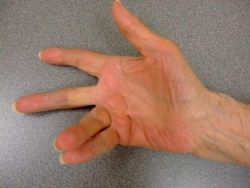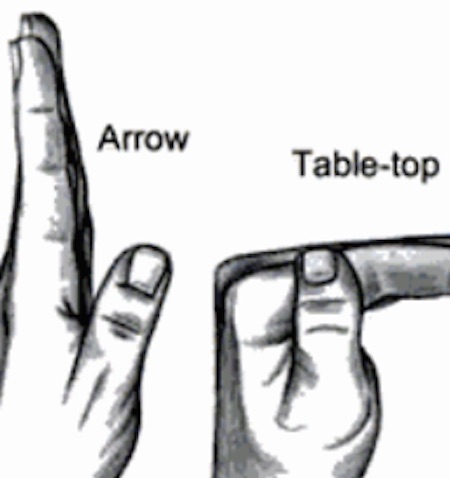Needle Aponeurotomy for Dupuytren's Disease
The Hand Center of Western Massachusetts is one of the few places in the region where needle aponeurotomy for Dupuytren's disease is being performed. While not all patients are candidates for needle aponeurotomy, there are many patients who may benefit from this technique.
What is Dupuytren's Disease?
Dupuytren's disease is a genetic problem which affects the fascia or connective tissue on the palmar aspect of the digits and hands. Fascia is the tissue that provides contour and wrinkles to the hand. In Dupuytren's disease the body tends to make too much and a somewhat abnormal type of fascia. This presents as nodules and cords on the palm side of the hand and fingers. Ultimately this may lead to contractures of the fingers and thumb.
What is Needle Aponeurotomy?
Needle aponeurotomy uses a small gauge needle as a cutting device to sever the abnormal cords of tissue in the palm and digits which cause the fingers to flex down. Following the procedure, the patient requires only bandaids for the small puncture wounds and intermittent use of an ice pack for several days. The patient is allowed to use the hand and shower the same day. Since no general or sedating anesthesia is required, the patient may need not fast before the procedure. There is also no need to stop any regular medications prior to the procedure.
What are the potential benefits?
The surgeon essentially releases the pathologic cords through a number of small puncture wounds thereby avoiding larger skin incisions more typical of the "open" procedure. In addition to avoiding more extensive skin incisions the need for formal surgery, extensive healing time and postoperative rehabilitative course is also avoided. For many patients undergoing this procedure, this reduces the immediate problem of using the hand more fully in the early post operative period. It does not mean that there will be absolutely no discomfort, but many patients feel less initial pain. One must also realize that there are many people who undergo so called regular "open" Dupuytren's fascial excision who ultimately experience similar good results after several months. It is also felt that an open procedure carries a lesser risk of recurrence over a number of years. However, those patients who undergo needle aponeurotomy, on average, have less palmar discomfort and greater functionality sooner than their "open" surgery counterparts. These benefits are measured often in days to weeks rather than weeks to months.
Must my Dupuytren's contractures be treated by needle aponeurotomy?
No. It is important to understand that this is one method for treating Dupuytren's contractures. Standard "open" fascial excision and contracture release with open palm technique is still a tried and true method of surgery and typically has very good results.
Can all Dupuytren's disease be treated by needle aponeurotomy?
No. Sometimes the disease process is too far advanced to be amenable to this procedure. Also, nodules as opposed to fascial cords cannot be treated with this technique. Although nodules cannot be removed using this technique, this form of Dupuytren's disease can be in injected with cortisone to partially decrease the swelling and discomfort in these areas. Also, previous surgeries and other types of anatomic considerations may not allow the safe use of this technique. It is important to discuss the specifics of your case with a qualified hand surgeon familiar with both techniques.
What kind of results can I expect?
Although a significant amount of correction is possible, a greater degree of flexion contracture initially will result in a greater chance of some residual deformity following the procedure. Also, contractures of the metacarpophalangeal (MCP) joints are more amenable to correction than those of the proximal interphalangeal (PIP) joints. The above is a typical case performed by our surgeons at the Hand Center of Western Massachusetts.
What should I do if I want to have this procedure?
There are several different ways of treating Dupuytren's disease with flexion contractures. You should make sure your surgeon has training and experience in their chosen method of treatment. Often the experience of having done the open standard technique for many years gives a greater understanding of the anatomy that is affected. There is no good way at present to image abnormal Dupuytrens tissue for use in clinical situations and the surgeon must rely upon their knowledge of anatomy to do the procedure. For this reason, fellowship trained and experienced Hand Surgeons do this type of procedure.
Where is the surgery done?
Unlike open Dupuytren's fascial excision, needle aponeurotomy is typically performed by our surgeons in the office at The Hand Center of Western Massachusetts. For more information, it is necessary for you to speak to a physician who can review your specific case and determine whether you might be a candidate for this procedure. This page is intended solely as an introduction to this topic.








 copy.jpg)
